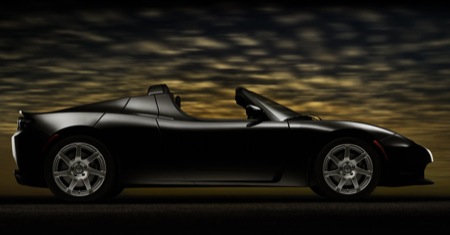Tesla Motors Announces Some News
On Wednesday, Tesla Motors Chairman Elon Musk announced some changes at the company. In a nutshell, they are going to:
- Work to be cash-flow positive within six to nine months.
- Ramp up the delivery rate for pre-sold Roadsters.
- Build revenue from powertrain sales to other car companies.
- Musk will replace Ze'ev Drori as CEO.
- Drori will remain as vice-chairman of the board.
- Scale back Model S work until their assembly site passes the environmental review.
- Delay the production target for the Model S by six months.
- Finance Model S production primarily with a low-interest DOE loan.
- Implement a modest reduction in near-term headcount.
- Survive the economic turmoil on Musk's dime for as long as it takes.
The media and blogosphere as been laser-focused on writing copycat stories on how the current economic problems have led Tesla to layoffs and the Model S delay. That generates eye-catching headlines, but it misses the real story.
Building a New Car Company
In February of 2007, Tesla announced their assembly plant would be in New Mexico. After over a year of silence on that, they announced a new plan in September: assembly plant in California. Clearly things aren't going as smoothly as Tesla had hoped.
Of course the Model S got delayed. They were running on a very tight schedule to deliver the Model S in late 2010. To get to that point, there's an incredible amount of work for them to do. Apparently they have made good progress designing the sedan, both inside and outside, but that's just the beginning. They also have to design and build a production facility and the assembly line tools and process, and create supplier relationships that will be 100% reliable. There's a lot of that work that depends on knowing when and where they are going to build their assembly facility. If and until they get the environmental approval for the San Jose site, they don't know either.
Also tied to the environmental approval is the DOE loan. If they wait for the loan to provide the majority of funding needed to develop the Model S, the Tesla investors can avoid giving up equity in another round of financing, e.g. an IPO. Right now, raising money from investors is more expensive, which further increases the appeal of the DOE loan. So of course they need to delay spending money unnecessarily until they can get the DOE funds.
Thus, cost cutting and modest layoffs. Now that they expect to have their headquarters located at their production facility, they want to consolidate operations. Combine that with Roadster design work being finished in Hethel, and some general belt-tightening and you have some layoffs. That's bad news for the Tesla people who will lose their jobs. I've met a number of Tesla employees and I've been universally impressed. They are a bright, enthusiastic bunch doing amazing and important work. I hate to think of people of that caliber losing their jobs. I hope they are able to quickly apply their talents to new jobs. It's bad news for those people, but it's not bad news for Tesla. It's just a matter of Tesla staying lean until they know when and where their Model S production facility will be built and can get working 100% on that huge effort.
The Real Risk
Here's the scariest part of Musk's announcement:
If all goes reasonably well, we will receive [the environmental] approval in Q2 next year.
Have you ever heard of an environmental approval going smoothly? If something kills Tesla Motors, it's not going to be the Wall Street fiasco, it's going to be some wet patch of dirt or an endangered species we've probably never even heard of. It's ironic that a company trying to develop technology to help save the global environment from man-made disaster is at risk of failure because of one of the literally millions of species that are threatened by the problem that Tesla would like to help solve.
But the media is having lots of fun writing about the subprime loan mess, reckless unregulated banking, and the resulting panicked federal intervention spending spree, so that's what they are writing about.
The Good News: Profits
There's even another thread to this story that has been completely missed:
Our powertrain business is profitable today and is also growing rapidly.
What is that all about? We've heard rumors that Tesla is working on an electric powertrain for another auto maker, but nothing has been confirmed. Now Musk tells us that not only are they doing it, but that it's already profitable. That's real news! That could be the single most important thing that Tesla has announced all year. It could be the beginning of a business model that puts Tesla's technology into vehicles in quantities that will show the world that the Roadster was just a successful gesture to get people thinking about electric vehicle technology.
It could well be the direct path to achieve Tesla's goal to reduce our global dependence on burning petroleum which is damaging our global climate, funding horrible governments around the world, and betting the entire free world economy on the whims of those undemocratic governments.
But how is the media going to work that into a story about today's immediate financial crisis? Especially if we have to ask questions and do research instead of just writing the same story everyone else is writing; that's just too hard.

